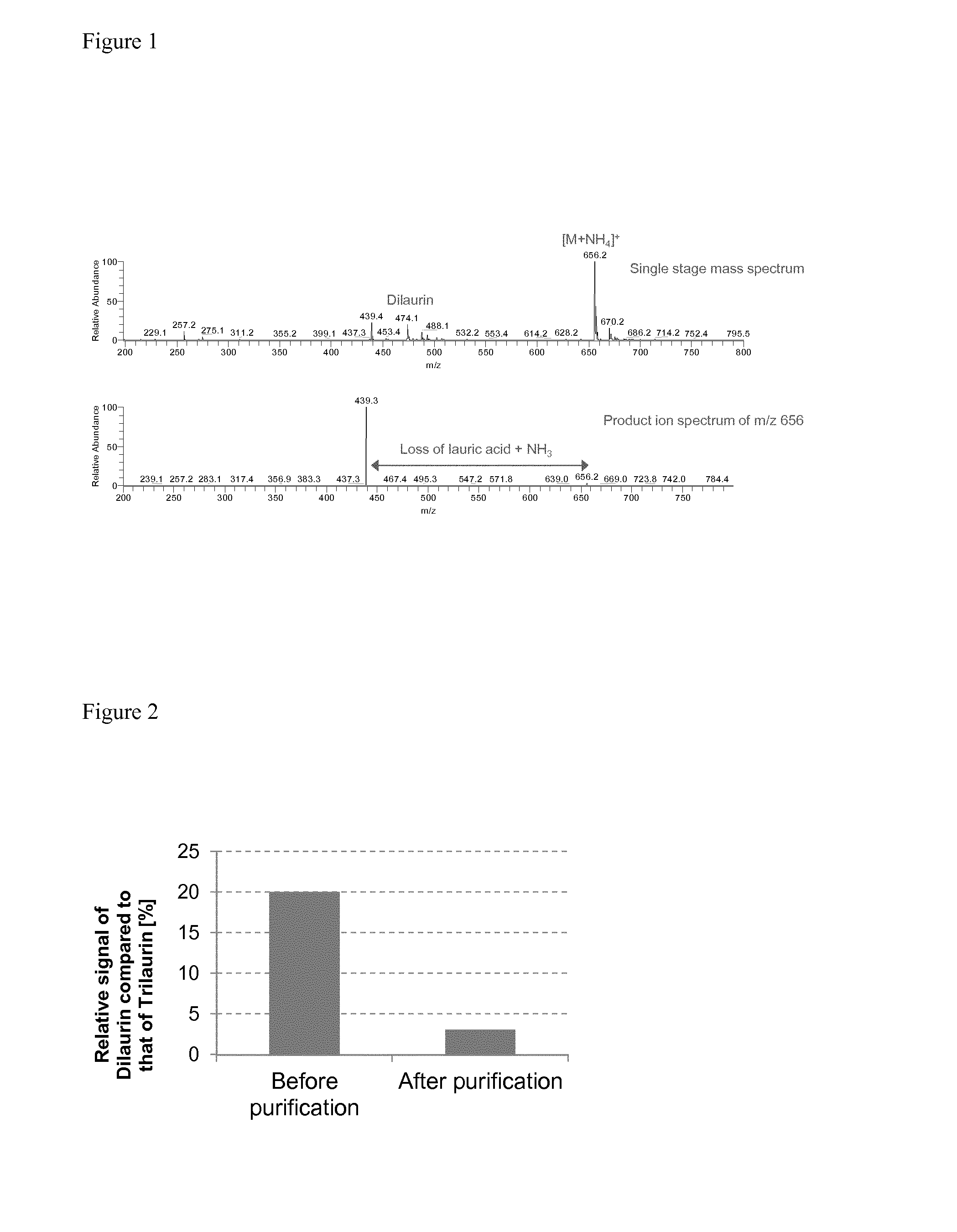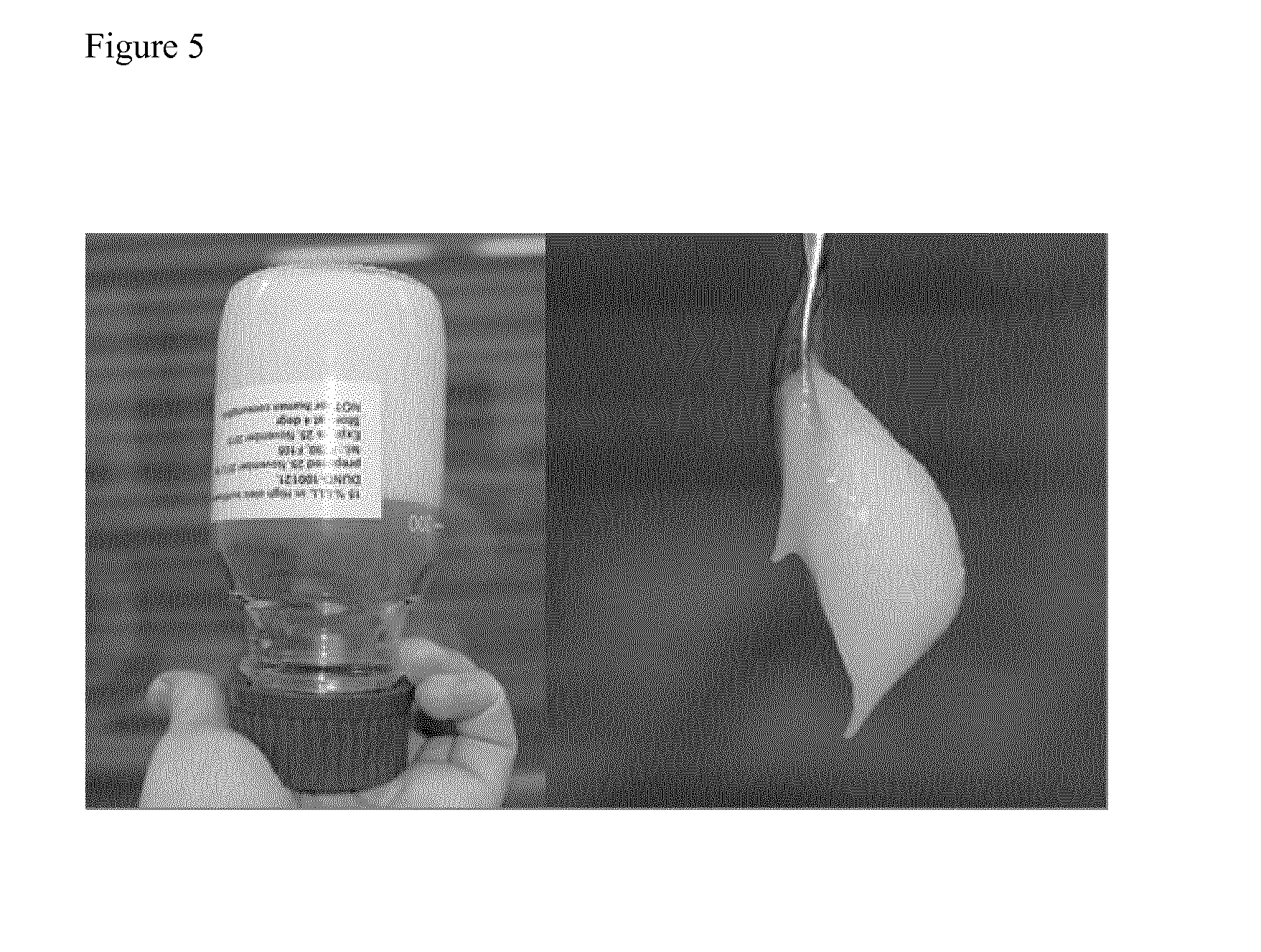Lauric fat based structuring agents to reduce saturated fat
- Summary
- Abstract
- Description
- Claims
- Application Information
AI Technical Summary
Benefits of technology
Problems solved by technology
Method used
Image
Examples
example 1
Production of Structuring Agent Trialurin
Esterification
[0063]Lauric acid and glycerol were mixed in a relative proportion of 3.3:1 corresponding to the theoretical reaction stoichiometry of the desired final triacylglycerol (TAG) plus 10% lauric acid excess. 1% sodium methanolate was added as base and the reaction was carried out at 200° C. for 2 h to ensure equilibrium. Single and tandem stage mass spectrometric characterization (for details see below) of this reaction mixture confirmed the formation of trilaurin: FIG. 1 depicts the observed pseudomoelcular ion with m / z 656. Note, that signals corresponding to the residual amount of dilaurin are also present in the single stage spectrum. FIG. 1 also shows the fragmentation pattern of parent ion m / z 656 reflecting the loss of lauric acid—bottom part. (FIG. 1.)
Purification of Structuring Agent
[0064]The reaction mixture was purified to remove the base and eliminate the residual dilaurin. 10 mL reaction mixture was subjected to liquid-...
example 2
Preparation of a Structured Lipid Composition
[0065]The structuring agent prepared in Example 1 was melted at 60° C., then added at a level of 20% by weight to a likewise at 60° C. liquid oil, the oil being a high oleic sunflower oil. The high oleic sunflower oil had a saturated fatty acid content of 8% as determined by the classical transmethylation gas-chromatpgraphy method [W. W. Christie, Gas Chromatography and Lipids—A Practical Guide, The Oily Press, Dundee, UK. (1989)]. The oil and structuring agent were homogenized by briefly vortexing the mixture. This mixture was liquid and remained for hours liquid at room temperature. The mixture solidified within an hour when cooled to 4° C. and retained its gel structure when brought back to room temperature. This lipid composition contained 20% of structuring agent and had a total saturated fatty acid content of 28%.
example 3
Solidification Comparison of a Structured Lipid Composition
[0066]The lipid composition prepared in Example 2 was compared to pure high oleic sunflower oil (saturated fatty acid content of 8%) and a mixture of high oleic sunflower oil and coconut oil 7:3 (saturated fatty acid content of 33%). All mixtures were first melted at 60° C., cooled to 4° C. and then let stand at room temperature for a day. FIG. 3 shows that high oleic sunflower oil and the mixture of high oleic sunflower oil and coconut oil 7:3 appeared completely liquid. The lipid composition prepared in Example 2 remained solidified despite the fact that its saturated fatty acid content was lower than that of the mixture of high oleic sunflower oil and coconut oil 7:3. (FIG. 3.)
PUM
 Login to View More
Login to View More Abstract
Description
Claims
Application Information
 Login to View More
Login to View More - R&D
- Intellectual Property
- Life Sciences
- Materials
- Tech Scout
- Unparalleled Data Quality
- Higher Quality Content
- 60% Fewer Hallucinations
Browse by: Latest US Patents, China's latest patents, Technical Efficacy Thesaurus, Application Domain, Technology Topic, Popular Technical Reports.
© 2025 PatSnap. All rights reserved.Legal|Privacy policy|Modern Slavery Act Transparency Statement|Sitemap|About US| Contact US: help@patsnap.com



